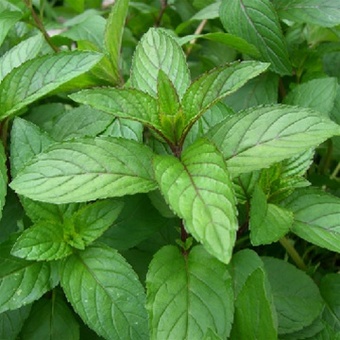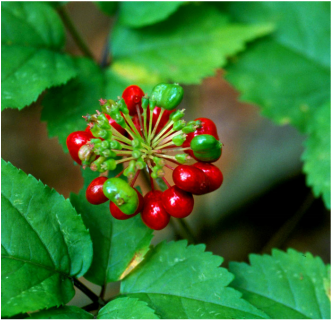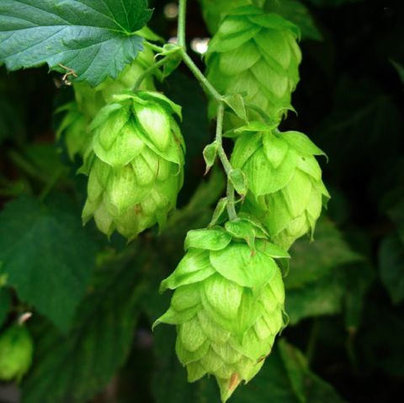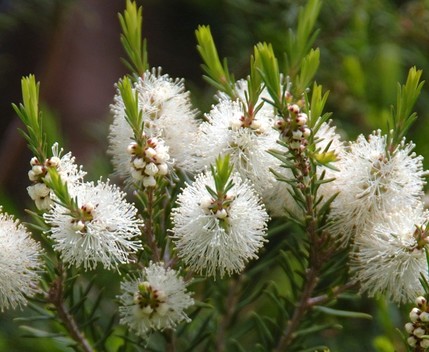*The information on this page was compiled and written by Adam from AnnunakiGenetics throughout the entirety of 2015. It is not intended or implied to be a substitute for professional medical advice, diagnosis or treatment. All content, including text, images and information, contained on this web page is for general information purposes only and shall not be reproduced without expressed written consent. You are encouraged to confirm any information obtained from or through this web site with other sources.
Copyright 2021.
Terpenes, also known as isoprenoids, are a class of aromatic hydrocarbons that occur naturally and abundantly in plants, humans, animals, and insects. They are the oldest and largest group of aromatic organic compounds found in nature, which are comprised of over 20,000 distinct molecules! These molecules are typically volatile and evaporate easily, however, even with their delicate nature 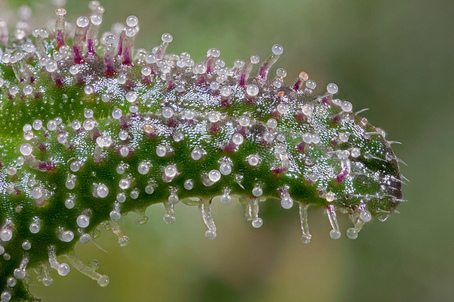 they are often the main building blocks for larger and more complex molecules such as vitamins, carotenoids, hormones, steroids, and cannabinoids. Terpenes are the primary constituents in all resins, saps, and essential oils, and are directly responsible for the fragrances of over 60,000 flowering plants! The word “terpene” stems from turpentine, which is a solvent that is distilled from pine sap.
they are often the main building blocks for larger and more complex molecules such as vitamins, carotenoids, hormones, steroids, and cannabinoids. Terpenes are the primary constituents in all resins, saps, and essential oils, and are directly responsible for the fragrances of over 60,000 flowering plants! The word “terpene” stems from turpentine, which is a solvent that is distilled from pine sap.
Terpenes are unsaturated compounds, and are formed by joining together units of isoprene (which is a hydrocarbon that consists of five carbon atoms attached to eight hydrogen atoms). The terpenes are divided in groups according to the number of isoprene units in the molecule: monoterpenes contain two units; sesquiterpenes have three; diterpenes, four; and so on. The majority of terpenes are simple hydrocarbons, but when they are modified chemically such as being denatured by oxidation (when drying and curing), or when a rearrangement of the carbon skeleton occurs the terpene then becomes a terpenoid. Esters, alcohols, aldehydes, and ketones are all examples of this, and they exude their own aromas.
In cannabis sativa the terpenes and cannabinoids share a biochemical precursor known as geranyl pyrophosphate, which is developed in the resinous glandular trichomes of the plant. The geranyl pyrophosphate evolves into the cannabinoids and terpenes themselves. There are many factors that influence the rate at which terpenes are produced, such as the climate, the maturity of the plant, nutrients, soil type, and even the time of day, but when it really comes down to it terpenes are continuously being renewed and replaced as they evaporate from the resin.
Different plant species produce distinct terpene profiles. Pine trees for example, all produce pinene as their major terpenoid, while most rose species produce geraniol and citronellol as there primary terpenoids. But cannabis varieties are unique, in that they have the capacity to produce numerous terpene profiles without one particular terpene dominating the species. This may be partly because there are over 120 known terpenes that have been identified in cannabis alone, with as many as 40 different ones found in a single plant! Many cannabis strains produce Myrcene as their dominant terpene, while other strains show Pinene or Limonene as their principle terpene. Some terpenes like, Eucalyptol, Carene, and Phellandrene are found almost exclusively in sativa varieties, and rarely in indica varieties, while other terpenes like Myrcene and Guaiol are found primarily in indica/afghan varieties, and seldom in sativas. The range of scents expressed by cannabis is so extensive that it’s almost unimaginable. The majority of them appear in such small amounts that they are not noteworthy, or “noseworthy” as it were, but even still, there is no other plant on Earth that rivals the cacophony of smells and tastes that cannabis produces.
 The great variety of aromas that cannabis exudes is impressive, and like many other aromatic flowers in the plant kingdom, cannabis has developed its terpenes to serve many evolutionary purposes.
The great variety of aromas that cannabis exudes is impressive, and like many other aromatic flowers in the plant kingdom, cannabis has developed its terpenes to serve many evolutionary purposes.
Many terpenes are able to interact with other active compounds, such as cannabinoids and other terpenoids, which then modulate and influence the physiological and psychoactive effects of the cannabis flowers. This is what’s referred to as the “entourage effect”- when some combinations of terpenes (and cannabinoids) work together to produce a synergy of effects. Some are antagonists which serve to catalyze or inhibit the formation of other compounds within the plant, while others increase the assimilation of THC, and are able to modify how much THC passes through the blood-brain barrier. There are some terpenes that even go as far as to regulate the rate of production and decomposition of neurotransmitters like dopamine and serotonin, the two main regulators of mood and behavior. Many terpenes serve to naturally repel predators, parasites, and pathogenic microbes, while other terpenes attract beneficial insects.
A strains terpene profile is the most accurate fingerprint we have to delineate one strain (or phenotype) from another. Terpenes also serve as a great means of determining a specific strains’ medicinal values before the buds are utilized. After one has learned about the different terpene profiles it becomes apparent why, and how different cannabis strains produce unique variations in the smell, taste and effects of the buds they are found in.
Listed below are 26 of the most commonly found terpenes in cannabis, in alphabetical order.

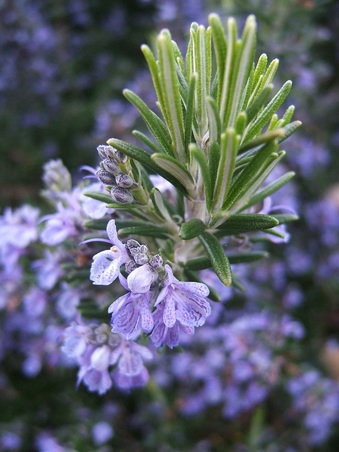
Rosemary
Borneol
Boiling point:
410° F
Description:
Borneol, which was formerly known as Borneo Camphor, is a naturally occurring organic compound. It’s composed of two isoprene rings that are fused together, which makes it a bicyclic monoterpene. It’s larger than other monoterpenes like limonene, yet smaller than sesquiterpenes like caryophyllene.
Found in:
The most common occurrences of borneol is found in several species of plants and trees native to southeast Asia and Borneo (from which its name is derived). Borneol is found in high concentrations in camphor wood, rosemary, mango, mint, cinnamon, wormwood, basil, and coriander. It’s derived from many essential oils too, including rosemary oil, spike oil, sage oil, fir oil, pine oil, hemlock oil, tansy oil, kesso oil, feverfew oil, golden rod oil, citronella oil, coriander oil, and thyme oil.
Aroma:
Borneol is described as having a menthol, woody, camphorous, herbal aroma.
Medicinal value:
Chinese traditional medicine has used borneol as a moxa for acupuncture both topically and orally since at least the late 1600s. It’s considered a calming sedative and is used in medicine to fight fatigue and stress, and to help recover from illness. Borneol is also used as a skin tonic, local anesthetic, and an antispasmodic. Borneol has long been understood to potentiate the effects of numerous other drugs, thereby increasing their effectiveness. It does this by increasing how much of a drug is absorbed by the body. Much like myrcene, it lowers the blood-brain barrier, allowing better absorption in the brain. In addition to all of these other medicinal properties Borneol is used as a natural insect repellent, keeping away mosquitoes, fleas and other pathogen carrying insects that could be spreading the West Nile virus and other diseases.
Uses:
Borneol is used in the manufacturing of perfumes and other aroma products. It’s also used in small amounts as a flavoring agent in over the counter medicines, particularly in Asia.
|
Physiological effects:
Analgesic – Relieves pain. Antibiotic – Destroys or kills established microorganism. Anti-bacterial – Destroys or inhibits further bacterial growth. Anti-candidal – Treats candida infections. Anticoagulant – Prevents the formation of blood clots. Anti-fibrosis – Balances the body’s fibrosis response to injury. Anti-fungal – Inhibits the growth of fungus. Anti-inflammatory – Reduces inflammation systemically. |
|

Bisabolol
Boiling point:
307° F
Description:
Bisabolol, αlpha-Bisabolol, or Levomenol, is a monocyclic sesquiterpene alcohol.

German Chamomile
Found in:
Bisabolol is obtained by distillation from the wood of the candeia tree which is native to the savannahs in the southeastern part of Brazil. It is also found naturally in bergamot orange, mango, and German chamomile, and is a constituent in their essential oils.
Aroma:
Pleasant and sweet, Bisabolol has a delicate, citrus, floral note.
Medicinal value:
Bisabolol has long been used in medicine to fight inflammation. It is unique in that it has the ability to surpass the blood-brain barrier and enter the brain tissue. It has shown to help with burn lesions by significantly reducing the healing time, it can induce apoptosis (the death of cells that occurs as a normal and controlled part of an organism’s growth) in leukemia, and it has microbial properties against gram positive bacteria such as staphaureus, staph. epidermidis, corynebacteria, as well as fungi trichophyton species and Candida albicans.
Uses:
Bisabolol is used in various fragrances, and is commonly found in cosmetics due to its perceived softening and soothing skin benefits. Its non-toxic and is formulated for sensitive skin. It’s used in many applications including after-shave products, sun care, after sun, baby care, lip-protectors, and tooth pastes.
Physiological effects:
|
Analgesic – Relieves pain. Anti-arthritic – Relieves the symptoms of arthritis. Anti-bacterial – Destroys or inhibits further bacterial growth. Antibiotic – Destroys or kills established microorganism. Anti-fungal – Inhibits the growth of fungus. Anti-inflammatory – Reduces inflammation systemically. Anti-microbial – Destroys or inhibits further growth of microorganisms. |
Antineoplastic – Prevents or inhibits the maturation and proliferation of malignant cells.
Antioxidant – Prevents oxidation damage to other molecules in the body. Anti-pyrotic – Effective in the treatment of burns. Antiseptic – Prevents or inhibits microorganisms. Antiulcerogenic- Prevents or heals ulcers. |

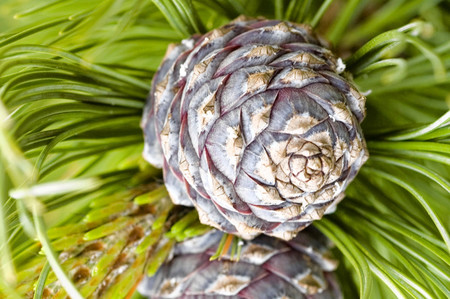
Siberian Pine
Boiling point:
318° F
Description:
Camphene is a bicyclic monoterpene which is obtained by the isomerization of α-Pinene. It is the only terpene known to be a solid.
Found in:
Camphene is commonly found in cumin, cinnamon, coriander, thyme, pepper, sage, cypress, eucalyptus, anise, cedar, vanilla, basil, curry, and tarragon. It’s a major constituent in the oil of Siberian pine, and a minor constituent in many essential oils extracted from trees and plants such as turpentine oil, cypress oil, thyme oil, camphor oil, hyssop oil, calamint oil, citronella oil, eucalyptus oil, lemon oil, burgamot oil, ginger oil, neroli oil, and valerian oil.
Aroma:
It’s odor has been described as camphoraceous, herbal, piney, and woody. It also has citrus, green, and minty nuances.
Medicinal value:
Camphene has recently been shown to be effective for pain relief and as an anti-oxidant. It cures viral, bacterial and fungal infections of the respiratory system and gives miraculous relief in congestion. It’s very effective in curing almost all varieties of respiratory disorders including chronic and acute bronchitis. It’s beneficial in curing all types of bacterial infections both inside and outside of the body. It cures bacteria infections like B-Colitis, renal colic, and infections in the genitals, urethra, intestines, and respiratory system. It also keeps bacteria away from the organs in the body.
Uses:
Camphene has been used since the mid 19th century as a fuel for lamps, but was limited by its explosiveness. It’s used in many applications including in medicine, in the preparation of fragrances, as a flavoring ingredient in food, and even in pesticides.
Physiological effects:
|
Analgesic – Relieves pain.
Anti-bacterial – Destroys or inhibits further bacterial growth. Anti-cholesterolgenic- Reduces the occurence of heart disease. Antioxidant – Prevents the damage of oxidation to other molecules in the body. Antiseptic – Prevents or inhibits microorganisms. |
Brochodilator – Increases airflow to the lungs.
Decongestant – Relieves nasal congestion. Expectorant – Helps discharge phlegm from the respiratory tract. Insecticide – Kills insects. Sedative – Calms, soothes, and promotes sleep |

Boiling point:
334.4° F
Description:
Carene, or deltaΔ3-carene, is a bicyclic monoterpene which occurs naturally as a constituent of turpentine.
Found in:
deltaΔ3-Carene is commonly found in rosemary, mango, anise seed, turpentine, pine, cypress, cedar, European silver fir, Siberian fir, Canadian fir, Balsam fir, and Douglas firs, and their resins. It’s primarily found in sativa dominant cannabis strains with few occurrences in indica dominant strains.
Aroma:
The aroma is sweet, with pungent cedar, lemon, and turpentine notes.
Medicinal value:
In aroma therapy, oils that have high levels of deltaΔ3-carene can be used to regulate excess fluids, as it dries tears, runny noses, perspiration, and menstrual flows. It is thought to be partially responsible for the dry eyes and cotton-mouth that are experienced by some marijuana users. Additionally, anti-inflammatory properties have been found in Carene which helps to treat joint pain and multiple sclerosis.
Physiological effects:
|
AChE inhibitor – Stops the action of the protein that destroys acetylcholine.
Anti-bacterial – Destroys or inhibits further bacterial growth. Anti-fungal – Destroys or inhibits the growth of fungus. Antihistamine – Relieves or controls allergic symptoms and colds. Anti-inflammatory – Reduces inflammation systemically. Antiseptic – Prevents or inhibits microorganisms. Sedative – Calms, soothes, and promotes sleep |
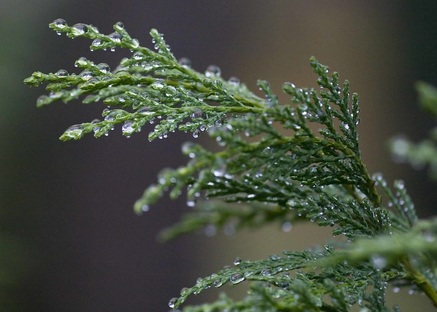 Cypress |

Boiling point:
246.2° F
Description:
Caryophyllene is a natural bicyclic sesquiterpene that is found in nearly all plants. It is composed of three isoprene units, which makes it larger than monoterpenes like Pinene, Limonene, and Myrcene, which are made up of only two isomers. The three compounds (isoprene units) are αlpha-Caryophyllene (also known as αlpha-Humulene, and βeta-Caryophyllene, which is the main component of the essential oil of black pepper, and also Caryophyllene oxide, which is the result of the oxidation of β-Caryophyllene.
Found in:
Caryophyllene is a major constituent in black pepper, cloves, hops, thai basil, calamus, oregano, chamomile, rosemary, fever plant, caraway, mango, and cotton. It is found in smaller percentages in many green, leafy vegetables, and herbs and spices. Additionally, it is found in many essential oils including clove oil, clove stem oil, lavender oil, hops oil, canella alba oil, eucalyptus oil, citrus oil sage oil, thyme oil, pimenta oil, and oil of cinnamon root. Caryophyllene is present in all cannabis varieties and is the most common terpene found in decarboxylated extracts since it typically survives extraction temperatures that monoterpenes will not.
Aroma:
Caryophyllene has a spicy, peppery, dry, woody, lemon balm odor, and has a sweet, camphorous taste with astringent citrus backgrounds.
Medicinal value:

Black Pepper
Caryophyllene joins Cannabichromene and Cannabidiol in the fight against fungal attacks. β-Caryophyllene has analgesic and anti-inflammatory properties and operates at two levels. One is by blocking the prostaglandins’ inflammatory pathway, as happens with Myrcene and Pinene, and the other is as a CB2 cannabinoid receptor antagonist, which binds with the CB2 endocannabinoid receptor.
This last mode of action makes β-caryophyllene the only non-cannabinoid molecule with cannabinomimetic functioning. Since β-caryophyllene does not bind to the CB1 receptor it does not exert psychomimetic effects. Due to its effects on the prostaglandins inflammatory pathway, Caryophyllene also has anticoagulant properties and gastric protection effects. It is particularly effective in the treatment of atypical dermatitis when used topically, and in high amounts it’s a calcium and potassium ion channel blocker. As a result, it impedes the pressure exerted by heart muscles, and eases nerve pain and ulcers. What is more is that In the plant kingdom, Caryophyllene oxide takes part in the defense system of plants, functioning both as an insecticide and as an anti-fungal agent.
Uses:
Caryophyllene is an FDA approved food additive, and is commonly used in the beer brewing process, as well as being used industrially to enhance the flavor of tobacco. The oxidized form of Caryophyllene (Caryophyllene oxide) is the substance in cannabis that is identifiable by drug-sniffing dogs. Since THC (and all cannabinoids) are odorless, drug dogs are trained to recognize and search for this very potent molecule!
Physiological effects:
|
Analgesic – Relieves pain.
Anthelmintic – Expels or destroys parasitic worms. Antihistamine – Relieves or controls allergic symptoms and colds. Anti-bacterial – Destroys or inhibits further bacterial growth. Anticoagulant – Prevents the formation of blood clots. Anti-depressant – Relieves symptoms of depression. Anti-fungal – Destroys or inhibits the growth of fungus. Anti-inflammatory – Reduces inflammation systemically. Antinociceptive – Reduces sensitivity to pain. Anti-malarial – Prevents or cures Malaria. Antineoplastic – Prevents or inhibits the maturation and proliferation of malignant cells. Antiseptic – Prevents or inhibits microorganisms. |
Anxiolitic – Relieves or inhibits anxiety.
Gastric cytoprotective- Protection against gastric mucosal injury. Insecticide – Kills insects. Neuroprotective – Slows damage to the nervous system and brain.  Thai Basil |

Citronellol
Boiling point:
437° F
Description:
Citronellol, βeta-Citronellol, or Dihydrogeraniol, is a natural acyclic monoterpene alcohol that is closely related to Geraniol.
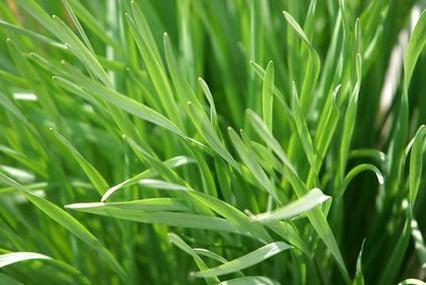
Lemongrass
Found in:
Citronellol is widely used around the world for various purposes and is mainly obtained from plants in the Poaceae family (lemon grasses)., It’s also commonly found in geranium, roses, lemon, mango, and of course, citronella, from which its name is derived. It has been found in the oils of eucalyptus, savin oil, rose oil, melissa oil, erigeron oil, spanish geranium oil, lemon oil, Lena Batu oil, and Maha Pen-giri oil.
Aroma:
It has a roseacious odor with lemon, cherry, and green fruit nuances.
Medicinal value:
Citronellol has shown to be deeply sedating upon inhalation. It’s an effective molecule against both E. Coli and Staph pathogens.
Uses:
Citronellol is most commonly known for the aroma it lends to citronella candle wax, which deters mosquitos and other insects. It’s also used to flavor foods and as a fragrance component in consumer products such as detergents, cosmetics, and perfumes.
Physiological effects:
|
Anthelmintic – Expels or destroys parasitic worms.
Anti-bacterial – Destroys or inhibits further bacterial growth. Anti-fungal – Destroys or inhibits the growth of fungus. Anti-herpetic – Inactivates herpes virus. Anti-inflammatory – Reduces inflammation systemically. Anti-insomnia – Aids in falling asleep or staying asleep. Anti-microbial – Destroys or inhibits further growth of microorganisms. |
Antineoplastic – Prevents or inhibits the maturation and proliferation of malignant cells. Anti-viral- Destroys or inhibits the growth and reproduction of viruses. Insectifuge – Repels insects. Sedative – Calms, soothes, and promotes sleep |

Boiling point:
350.6° F
Description:
Cymene, or para-Cymene, formerly known as Camphogen, is a volatile, naturally occurring aromatic monoterpenoid, and is a biological precursor of Carvacrol.
Found in: 
p-Cymene is present in volatile oils from over 200 plants and occurs naturally in many foods including orange juice, grape fruit, mango, tangerine, carrots, raspberries, butter, nutmeg, sweet marjoram, coriander, tarragon, oregano, and almost every spice. It’s also found in anise, cumin, mace, stinkwort, and eucalyptus. It’s a main constituent in a number of essential oils including cypress oil, cumin oil, thyme oil, caraway oil, carvacol oil, coriander oil, nutmeg oil, gascarilla oil, and marjoram oil.
Aroma:
Cymene has a pleasant woody, green citrus, kerosene-like aroma. It has spicy nuances reminiscent of carrots, cumin, oregano and cilantro.
Medicinal value:
It has documented anti-inflammatory effects, and shows potential protective effects against acute lung injury. p-cymene has also shown to have inhibitory effects against E. Coli.
Uses:
Cymene is an important intermediate used in the pharmaceutical industry for the production of fungicides and pesticides, and is used in the flavoring of beverages, cakes and confectionery, as well as soaps, cleaning solvents, and fragrances.
Physiological effects:
|
AChE inhibitor – Stops the action of the protein that destroys acetylcholine.
Analgesic – Relieves pain. Anthelmintic – Expels or destroys parasitic worms. Anti-bacterial – Destroys or inhibits further bacterial growth. Antibiotic – Destroys or kills established microorganism. |
Anti-candidal – Treats candida infections.
Anti-inflammatory – Reduces inflammation systemically. Anti-microbial – Destroys or inhibits further growth of microorganisms. Expectorant – Helps discharge phlegm from the respiratory tract. |
 Eucalyptol
EucalyptolBoiling Point:
348.8° F
Description:
Eucalyptol, which is also known as Cineole, 1,8-cineol, and Cajeputol, is a natural bicyclic monoterpene ether.
Found in:
Eucalyptol is only a minor constituent in cannabis, but is one of the most widely distributed constituents in the plant kingdom. Its found in high concentrations in tea trees, peppermint, mugwort, stinkwort, bay leaves, mango, rosemary, wormwood, basil, tea tree, camphor laurel, vanilla, fever plant, and comprises over 80% of the essential oil from eucalyptus trees. It plays a part in a multitude of other essential oils as well, including common sage oil, laurel berry and leaf oil, myrtle oil, oil of cheken-leaves, galanga oil, lavender oil, artemisia oil, spike oil, cinnamon oils, zedoary oil, canella oil, iva oil, basilicum oil, peppermint oil, Russian spearmint oil, camphor oil, dill seed oil, cardamom oil, hyssop oil, wormseed oil, oil of cajeput, coriander oil, sweet basil oil, and oil of rosemary.
Aroma:
Eucalyptol has a spicy, camphorous, refreshing, minty aroma.
Medicinal value:
Eucalyptol is considered to be centering, balancing and stimulating, which could influence the thought provoking part of the cannabis smoke stream. Its been shown to help with more ailments than other more commonly found terpenes, and since it has such tremendous therapeutic value it’s a subject of much interest. Studies
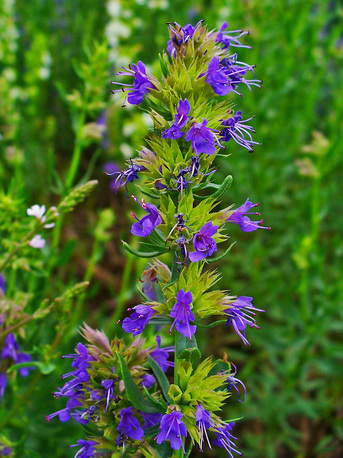
Hyssop
have shown that eucalyptol is an effective strategy to treat colo-rectal cancer, leukemia, and tuberculosis. It can easily cross the blood-brain-barrier, triggering a fast olfactory reaction. Its anti-inflammatory effects are powerful enough to be a potential treatment for Alzheimer’s as it increases cerebral blood flow and enhances cortical activity, and has also been shown to increase circulation and relieve pain. It’s the only terpene that is active in the central nervous system, and it can be said that the synergy between THC and Eucalyptol is what makes a notable difference regarding the activating effects of sativa varieties.
Uses:
Eucalyptol (or Cineole) is used in small quantities in food as a flavoring agent, in mouthwash and toothpaste to help stop tooth decay, and in cough drops as an antitussive. Eucalyptus oil is often added to cosmetic products like baby powder, lotions, creams, and soaps. It acts as a natural insect repellent, insecticide, and acaracide. One can add Eucalyptol (Eucalyptus oil) to their soapy water when washing their clothes to more effectively kill dust mites.
Physiological effects:
|
Acaracide- Kills members of the Acari family (mites and ticks).
AChE inhibitor – Stops the action of the protein that destroys acetylcholine. Analgesic – Relieves pain. Anthelmintic – Expels or destroys parasitic worms. Anti-bacterial – Destroys or inhibits further bacterial growth. Antibiotic – Destroys or kills established microorganism. Anti-cholesterolgenic- Reduces the occurence of heart disease. Anti-depressant – Relieves symptoms of depression. 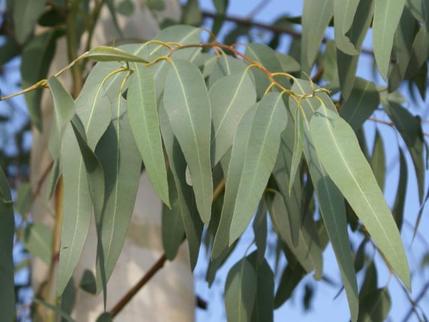 Eucalyptus |
Anti-fungal – Destroys or inhibits the growth of fungus.
Anti-inflammatory – Reduces inflammation systemically. Antineoplastic – Prevents or inhibits the maturation and proliferation of malignant cells. Antinociceptive – Reduces sensitivity to pain. Antioxidant – Prevents the damage of oxidation to other molecules in the body. Antiseptic – Prevents or inhibits microorganisms. Antitussive – Prevents or relieves coughing. Anti-viral- Destroys or inhibits the growth and reproduction of viruses. Brochodilator – Increases airflow to the lungs. Expectorant – Helps discharge phlegm from the respiratory tract. Immunosuppressive – Reduces the activation efficacy of the immune system. Insecticide – Kills insects. Insectifuge – Repels insects. Nootropic – Enhances memory or other cognitive functions. Stimulant – Raises levels of physiological or nervous activity in the body. |

Boiling point:
255.2° F
Description:

Peppermint
Farnesene is an acyclic sesquiterpene hydrocarbon that has three major forms- βeta-Farnesene, αlpha–Farnesene which occur naturally in nature, and allo-farnesene which does not.
Found in:
Farnesene occurs in hundreds of species of plants including black locust, Florida torrey, larch, honeysuckle, alfalfa, gardenia, chamomile, corn, black pepper, carrots, caraway, peppermint, mango, hops, grapes, apples, and citrus fruits. Farnesol is widely distributed in many essential oils such as citronella oil, neroli oil, cyclamen oil, lemon grass oil, tuberose oil, rose oil, musk oil, balsam oil, perilla oil, and galanga oil. Many types of insects also use Farnesene as an alarm pheromone. Perhaps the greatest occurrence is in aphid species where they release it when they are attacked by predators or upon their death, to warn away other aphids.
Aroma:
Farnesene has a characteristic green apple odor.
Medicinal value:
Like other sesquiterpenes, Farnesene serves an important role in medicine as it has the ability to surpass the blood-brain barrier and enter the brain tissue.
Uses:
Farnesene is used naturally by plants, insects, and mammals. It acts as a pheromone for several insects and mammals. Elephants use it for territorial marking, individual recognition, and mate attraction. Farnesene also acts as a food attractant for pests of apple trees (like codling moths), a natural pesticide to mites, an alarm pheromone in aphids, fire ants and termites, and a semiochemical and aggregation pheremone by insects. Additionally, several plant species, such as potatoes, thaliana, cotton, and peppermint have been shown to naturally synthesize this pheromone as an insect repellent. Farnesene has commercial use in the perfume industry to emphasize the odors of perfumes.
Physiological effects:
|
Acaracide- Kills members of the Acari family (mites and ticks).
Anti-bacterial – Destroys or inhibits further bacterial growth. Anti-candidal – Treats candida infections. Anti-fungal – Destroys or inhibits the growth of fungus. Anti-inflammatory – Reduces inflammation systemically. Anti-microbial – Destroys or inhibits further growth of microorganisms. Antioxidant – Prevents the damage of oxidation to other molecules in the body. Anti-viral- Destroys or inhibits the growth and reproduction of viruses. Insectifuge – Repels insects. |
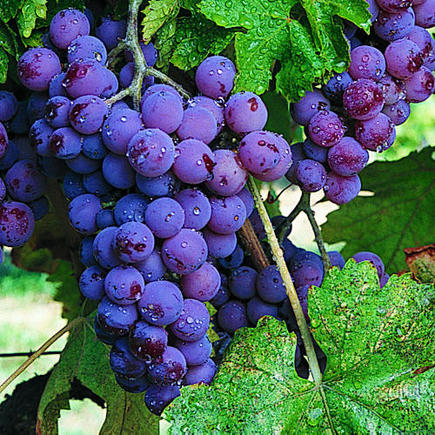 Grapes |
 Farnesol
FarnesolBoiling point:
231.8° F
Description:
Farnesol, or Dodecatrienol, is a natural acyclic sesquiterpene alcohol of which there are two isomers- cis and trans. It gets its name from Farnese acacia, the flower from which the compound was first derived. The “ol” in Farnesol indicates that the derivation is alcoholic in nature.
Found in:
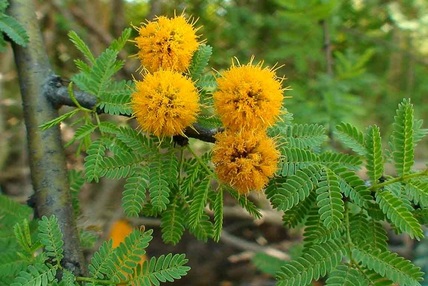
Acacia
Farnesol is found in the acacia tree, lemon grass, mango, star anise, cassia, calamus, musk seed, balsam, citronella and rose. It’s present in many essential oils including citronella oil, tuberose oil, rose oil, musk oil, balsam oil, and tolu oil.
Aroma:
The aroma is floral dominant, similar to lillys and violets, and has a mild, sweet, musk, linden tree odor.
Medicinal value:
Farnesol has been suggested to function as a chemopreventative, an anti-tumor agent, an analgesic, and it has the ability to pass through the blood-brain barrier and enter the brain tissue. When it’s inhaled as an aerosol it has the capability to kill cancer cells in the lungs. Additionally, it can kill the bacteria that is responsible for acne, and is commonly used in deodorant for the same properties.
Uses:
Farnesol is commonly used as a flavor enhancer in foods, an agent in cosmetics for its ability to regenerate skin cells, and in the perfume industry to sweeten floral perfumes. Additionally, it’s a natural pesticide for mites, and acts as an attractant pheromone in other insects. This could lend some explanation as to why some cannabis strains are more prone to mite infestations than others.
Physiological effects:
|
Analgesic – Relieves pain.
Anti-bacterial – Destroys or inhibits further bacterial growth. Anti-inflammatory – Reduces inflammation systemically. Anti-malarial – Prevents or cures Malaria. Antineoplastic – Prevents or inhibits the maturation and proliferation of malignant cells. |
Antioxidant – Prevents oxidation damage to other molecules in the body.
Antiseptic – Prevents or inhibits microorganisms. Insecticide – Kills insects. |

Boiling point:
394° F
Description:
Fenchol, αlpha-Fenchol, or Fenchyl alcohol, is a monoterpene alcohol and is an isomer of Borneol and Terpineol.
Found in:

St. Johns Wort
This compound is found in hops, basil, fennel, rosemary, lime, eucalyptus, horehound, West Indian woodnettle, mintbrush, mintweed, goatweed, pignut, wild spikenard, St. Johns wort, galbanum, myrtle, boldo, and scots pine.
Aroma:
Fenchol has a camphorous, piney, woody, dry, lemon scent.
Medicinal value:
Fenchol is known to exhibit anti-bacterial, antioxidant, and anti-microbial properties, with limited anti-fungal abilities.
Uses:
It’s used extensively in the fragrance industry, and as a flavor agent in foods and sodas.
Physiological effects:
|
Anti-bacterial – Destroys or inhibits further bacterial growth. Anti-fungal – Destroys or inhibits the growth of fungus. |
Anti-microbial – Destroys or inhibits further growth of microorganisms.
Antioxidant – Prevents oxidation damage to other molecules in the body. |
 Geraniol
GeraniolBoiling point:
446° F
Description:
Geraniol or βeta-Geraniol, which is also known as Lemonol, is a monoterpenoid alcohol that is structurally related to Citronellol, and is isomeric with Linalool.
Found in:
Geraniol is widely distributed in nature and is commonly found accompanying Linalool. It’s a constituent in roses, lemons, tea leaves, Douglas fir, bergamot, carrot, coriander, lavender, lemon, lime, nutmeg, orange, mango, rose, blueberry, blackberry, and most commonly, in the geranium plant, from which its name is derived. Geraniol is a fundamental part of many oils, including Indian and African geranium oils, palmarosa oil, citronella oil, eucalyptus oil, rose oil, thyme oil, neroli oil, petit-grain oil, spike oil, lignaloe oil, Lena Batu oil, Maha Pengiri oil, sassafras oil, Canadian snake root oil, gingergrass oil, lavender oil, melissa oil, lemon grass oil, and ylang-ylang oil.
Aroma:
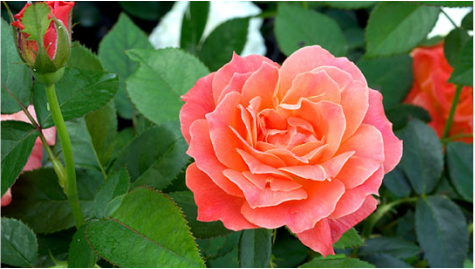
Rose
It has a primary floral, rose-geranium odor with apple, apricot, and citronella-like nuances.
Medicinal value:
Geraniol is a natural antioxidant, and shows a potential protective effect against neuropathy, and inhibits DNA synthesis. Recent studies have shown that Geraniol alone can suppress pancreatic tumor growth, and reduce colon tumor volume.
Uses:
Geraniol is a highly valued oil both in aromatherapy and in the perfume industry, and has uses in certain cosmetic applications. It’s commonly used in making fruit flavors such as peach, raspberry, grapefruit, red apple, plum, lime, orange, lemon, watermelon, pineapple, and blueberry. Much like Citronellol, Geraniol proves to be an effective plant-based mosquito repellent, while honey bees produce it naturally in their scent glands to help them mark nectar-bearing flowers. They also use Geraniol as an aggregation pheromone to mark the entrances to their hives.
Physiological effects:
|
Anti-bacterial – Destroys or inhibits further bacterial growth.
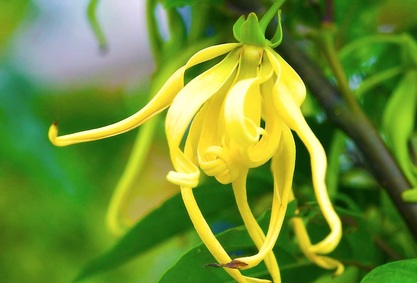 Ylang-ylang Anti-fungal – Destroys or inhibits the growth of fungus. |
Anti-microbial – Destroys or inhibits further growth of microorganisms.
Antineoplastic – Prevents or inhibits the maturation and proliferation of malignant cells. Antioxidant – Prevents the damage of oxidation to other molecules in the body. Anti-spasmodic – Suppresses muscle spasms. Anti-viral- Destroys or inhibits the growth and reproduction of viruses. Expectorant – Helps discharge phlegm from the respiratory tract. Insectifuge – Repels insects. |

Boiling point:
198° F
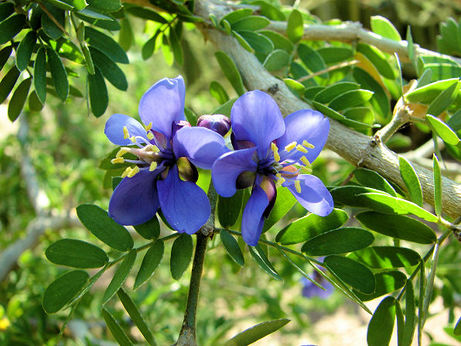
Guaiacum
Description:
Guaiolm, also known as Chamoacol, is a natural occurring sesquiterpene alcohol.
Found in:
It’s most commonly found in the oils of white cypress and guaiac wood, (or Guaiacum) which is a genus of slow-growing shrubs and trees native to the tropical Americas. It’s a pigment found in Blue Mushrooms and guaiacum flowers. It has been found that Afghani cannabis strains are likely to contain high ratios of Guaiol.
Aroma:
Guiaol has a floral smell similar to roses.
Medicinal value:
Guaiacum itself has been used for centuries in the treatment of coughs, arthritis, and syphilis. As with all sesquiterpenoids, Guiaol has the ability to surpass the blood-brain barrier and enter the brain tissue.
Physiological effects:
|
Anti-bacterial – Destroys or inhibits further bacterial growth.
Anti-arthritic – Relieves or prevent arthritic symptoms. Anti-inflammatory – Reduces inflammation systemically. Anti-microbial – Destroys or inhibits further growth of microorganisms. |
Antiseptic – Prevents or inhibits microorganisms.
Anti-syphilis – Prevents or cures syphilis. Antitussive – Prevents or relieves coughing. |


Hops
Boiling Point:
210° F
Description:
Humulene, or αlpha-humulene, is also commonly known as αlpha-caryophyllene, is a natural sesquiterpene, and is an isomer of βeta–Caryophyllene. Much like Myrcene, this compound is highly volatile.
Found in:
α-Humulene is one of the predominant terpenes found in Humulus Lupulus, the common hops, from which its name is derived. It has been found on every continent in an ever-increasing number of aromatic plants. It’s contained in the essential oils of many plants including common sage, pine trees, oranges, tobacco, sunflowers, Japanese spicebush, copaiba, ginseng, stinkwort, Chinese laurel tree, juniper, and Vietnamese coriander.
Aroma:
Humulene has elegant herbal, hoppy, cedar characters, similar to the spice in coriander. It is what gives beer its hoppy aroma.
Medicinal value:
Humulene is well known to Chinese medicine for its ability to minimize the body’s response to irritation, and as a major remedy for inflammation. It has the ability to pass though the blood-brain barrier and enter into the brain. It’s unique, because like THCv, it acts as an appetite suppressant, making it promising for weight loss treatments. Humulene is commonly accompanied by β–caryophyllene, which potentiates the anti-cancer effects of humulene. It also helps in the treatment of yellow fever.
Uses:
Humulene is most commonly used in the brewing industry to impart distinct flavors and aromas in beers. It also commonly used in the perfume industry.
Physiological effects:
|
Analgesic – Relieves pain.
Anorectic – Suppresses appetite and promotes weight loss. Anti-bacterial – Destroys or inhibits further bacterial growth. Anti-inflammatory – Reduces inflammation systemically. Antineoplastic – Prevents or inhibits the maturation and proliferation of malignant cells. Antiseptic – Prevents or inhibits microorganisms. |
Ginseng
|

Isopulegol
Boiling point:
413.6° F
Description:
Isopulegol, or Cyclohexanol, is a monocyclic monoterpene alcohol that is obtained as an intermediate compound during the synthesis of Menthol from Citronellol.
Found in:
Isopulegol is present in many aromatic plants including peppermint, eucalyptus, rhododon bush, mangos, and kaffir limes.

Kaffir lime
Aroma:
It has a strong minty, medicinal smell, with green, woody, herbaceous undertones.
Medicinal value:
Isopulegol has a variety of promising routes for therapeutic research. Some recent studies have shown that it has gastroprotective and anti-inflammatory effects, as well as having the ability to reduce the severity of seizures in animals.
Uses:
Isopulegol is used to supplement the natural sources of Menthol (oil of peppermint), and act as cooling agents. It imparts a cooling sensation to a variety of commercial products such as cosmetics, perfumes, personal care products, oral hygiene products, confectionery, cigarettes, cough drops, and nasal inhalants. Isopulegol is also widely used as a flavoring agent in food products.
Physiological effects:
|
Anxiolytic – Relieves anxiety.
Anti-bacterial – Destroys or inhibits further bacterial growth. Anti-convulsant – Prevents or reduces the severity and frequency of seizures. Anti-depressant – Relieves symptoms of depression. |
Anti-inflammatory – Reduces inflammation systemically.
Antioxidant – Prevents oxidation damage to other molecules in the body. Gastric cytoprotective- Protection against gastric mucosal injury. |


Orange
Limonene
Boiling point:
350.6° F
Description:
Limonene, designated in early literature as Hesperidene, Citrene, Cinene, and Carvene, is a cyclic carbohydrate monoterpene of major importance. It’s a chemical precursor to the terpenoid Carvone, and may be related to α-Pinene, from which it is formed. Next to Pinene, Limonene is the second most widely distributed terpene found in nature and it is an intermediate product in other terpenes’ biosynthesis.
Found in:
Limonene is most commonly found in the highest concentrations in the rinds of citrus fruits like oranges, mandarin, tangerine, lemon, lime, and grapefruit and is also a constituent in many other fruits, flowers, trees, and herbs including , rosemary, tarragon, juniper, peppermint, mango, European silver fir, Siberian fir, Canadian fir, Balsam fir, and Douglas firs, among others. Limonene is also found in the following ethereal oils: orange oil, lemon oil, mandarin oil, makrut lime peel oil, bergamot oil, citronella oil, caraway oil, dill oil, erigeron oil, kuromoji oil, bibchu oil, shaddock oil, dill seed oil, rue oil, wormseed oil, massoi bark oil, hyssop oil, neroli oil, petitgrain oil, cederleaf oil, ginger grass oil, cedro oil, buchu leaf oil, verbena oil, goldenrod oil, myrrh oil, celery oil, Russian and American peppermint and spearmint oils. Limonene is abundant in cannabis, being second only to Myrcene. However, it is more commonly detected in higher percentages in sativa dominant strains than in indicas, but it’s still found in both.
Aroma:
Limonene has three closely related forms. One of them smells mostly like tangerine, another smells like lemon, and the last one smells like grapefruit. Most of the research on the medicinal effects of Limonene have focused on the d-isomer which has a strong aroma of lemons which is where it gets its name. The aroma is both sweet and sour, with lemon and orange scents being the most prevalent.
Medicinal value:
Limonene has numerous medicinal benefits which include promoting weight loss, aiding in digestion, alleviating heartburn, and treating anxiety and depression. It has been used clinically to dissolve gallstones, improve mood, and relieve heartburn and gastrointestinal reflex. Citrus oils and extracts have been shown to alleviate symptoms of depression from the aroma alone. While testing the effects of Limonene, patients experienced an increase in attention, mental focus, well-being, and even sex drive. Additionally, Limonene has been shown to serve as an active anti-fungal agent making it a natural remedy against acne bacteria, athlete’s foot, toenail fungus, and outbreaks of yeast. Limonene produces apoptosis (the death of cells that occurs as a normal and controlled part of an organism’s growth) in breast cancer cells and prevents the deterioration of the RAS gene, one of the factors that contribute to the development of tumors, all while being an immunostimulant. Because of Limonene’s potent anti-carcinogenic and anti-fungal properties, it is thought to protect marijuana smokers from aspergillus fungi and certain carcinogens that can be found in cannabis smoke. Like Myrcene, Limonene can quickly and easily penetrates the blood-brain barrier, and can synergistically promote the absorption of other terpenes and chemicals through the skin, mucous membranes, and even the digestive tract, by quickly penetrating cell membranes resulting in in increased systolic blood pressure.
Uses:
In the past D-Limonene was primarily used in medicine, food, and perfumes before it became known for being the main active ingredient in citrus cleaning products which are organic, biodegradable, and environmentally friendly. Humans are rarely ever allergic to it, which is one reason why it is so commonly used in the cosmetics industry. It’s still widely used today in the pharmaceutical and food industries as flavoring, and it now plays a part in the 3D printing industry as well. Limonene acts as a natural insect repellent, paralyzing and killing insects like a synthetic organophosphate pesticide would. Yet, some other insects use Limonene as an aggregation pheromone.
Physiological effects:
|
Acaracide- Kills members of the Acari family (mites and ticks).
Anorectic – Suppresses appetite and promotes weight loss. Anthelmintic – Expels or destroys parasitic worms. Anti-bacterial – Destroys or inhibits further bacterial growth. Anti-candidal – Treats candida infections. Anti-depressant – Relieves symptoms of depression. Anti-fungal – Destroys or inhibits the growth of fungus. Anti-herpetic – Inactivates herpes virus. Anti-inflammatory – Reduces inflammation systemically. Anti-malarial – Prevents or cures Malaria. Antineoplastic – Prevents or inhibits the maturation and proliferation of malignant cells. Anti-viral- Destroys or inhibits the growth and reproduction of viruses. |
|

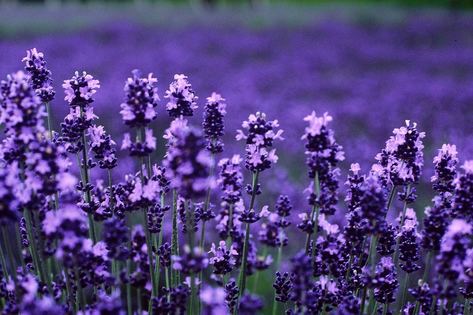
Lavender
Linalool
Boiling point:
388.4° F
Description:
Linalool, which is also known as β-linalool, p-linalool, linalyl alcohol, linaloyl oxide, licareol, and allo-ocimenol, is a naturally occurring lineal monoterpene alcohol, and is a critical precursor in the formation of Vitamin E.
Found in:
Linalool is found in the Lamiaceae family (mints, scented herbs), and the Rutaceae family (citrus fruits). It has been isolated in well over 200 plant species, from tropical to boreal climate zones. It’s a consituent in lavender, citrus fruits, grapes, bay laurel leaves, birch, coriander, rosewood, freesia, mango, mugwort, hops, peppermint, cinnamon, calamus, palmarosa grass, West Indian woodnettle, sweet marjoram, tea leaves, basil, Canada snake root, nutmeg, wartara, chupaca flowers, and even some fungi. It also makes up a good part of many essential oils including orange oil, lavender oil, rose oil, rosewood oil, coriander oil, ylang ylang oil, oil of cananga, melissa oil, petitgrain oil, oil of limes, oil of oregano, oil of bergamot, spike oil, ho wood oil, tangerine oil, spearmint oil, mandarin oil, lemon oil, cypress oil, grapefruit oil, cinnamon oil, chamomile oil, palmarossa oil, Russian spearmint oil, basilicum oil, linaloe oil, thyme oil, geranium, oil, neroli oil, and sassafras leaf oils. Many purple cannabis strains like Granddaddy Purple, Purple Urkle, Mendo Purps, and Grape Ape have elevated levels of Linalool.
Aroma:
Linalool is notorious for the pleasant floral odor it gives to lavender plants and other spring flowers. It’s commonly described as having a sweet candied-spice, woody, astringent aroma. Humans are able to smell it in very small concentrations; sometimes in as little as 1 part per million in the air!
Medicinal value:
Linalool has been used as a sleep aid for several thousand years. It acts as a sedative, and calms ones mood. Thus, Linalool is thought to be partly responsible for the sedative effects of certain marijuana strains. Linalool helps in the treatment of psychosis, anxiety, seizures, and various cancers. It also modulates the same (GABA) receptor types that Xanax does. The analgesic effects are further potentiated when it’s accompanied by CBD, so cannabis strains that possess high-Linalool and high-CBD levels have more potent analgesic properties than plants that are rich in only one of the two compounds. Linalool has also been shown to decrease morphine usage in post-surgical patients which may indicate that it has anti-addiction potential. Additionally, it has been well established that Linalool exhibits acute local anesthetic activity similar to lidocaine.
Uses:
Linalool is one of the most commonly researched terpenes due to its extensive use in aromatherapy. It’s a constituent in the majority of perfumed skin care products, as well as in cleaning agents including soaps, detergents, shampoos, lotions, flea dips, and insecticidal soaps. It’s vapors have been shown to be an effective insecticide against cockroaches, crickets, flies, fleas, fire ants, aphids, and mites. It acts as a contact poison that heightens sensory nerve activity in insects, causing massive over-stimulation of motor nerves that eventually leads to convulsion and paralysis.
Physiological effects:
|
Acaracide- Kills members of the Acari family (mites and ticks).
Analgesic – Relieves pain. Anthelmintic – Expels or destroys parasitic worms. Anti-bacterial – Destroys or inhibits further bacterial growth. Anti-fungal – Destroys or inhibits the growth of fungus. Antibiotic – Destroys or kills established microorganisms. |
Anti-depressant – Relieves symptoms of depression.
Anti-convulsant – Prevents or reduces the severity and frequency of seizures. Anti-inflammatory – Reduces inflammation systemically. Anti-insomnia – Aids in falling asleep or staying asleep. Anti-malarial – Prevents or cures Malaria. Anti-microbial – Destroys or inhibits further growth of microorganisms. Anti-mutagenic- Reduces the frequency or rate of mutation. Antineoplastic – Prevents or inhibits the maturation and proliferation of malignant cells. Antiparasitic- Destroys or inhibits the growth and reproduction of parasites. Anti-psychotic – Relieves symptoms of psychosis. Anti-spasmodic – Suppresses muscle spasms. Anti-viral- Destroys or inhibits the growth and reproduction of viruses. Anxiolytic – Relieves anxiety. Immunostimulant – Stimulates the immune system. Sedative – Calms, soothes, and promotes sleep |

Myrcene
Boiling point:
330.8° – 334.4° F
Description:
Myrcene, or β-Myrcene, is a lineal carbohydrate monoterpene. It’s the smallest of the terpenes, and is a precursor in the formation of other terpenes like Citronella and Geraniol. It gets its name from Myrcia sphaerocarpa, a medicinal shrub from Brazil.
Found in:
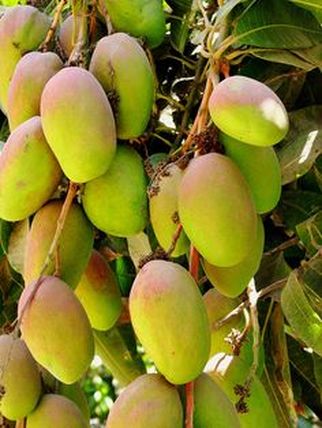
Mango
Myrcene is the sedative active ingredient in hops, where it’s found naturally in large quantities. It’s also found in Myrcia, West Indian bay tree leaves, cypress, hyssop, verbena, licorice, vanilla, anise, eucalyptus, ylang ylang, lemongrass, houttuynia, juniper, and thyme. It also occurs very commonly in fresh fruits like mango, peach, guava, lemon, grape, and pineapple. Myrcene is the most common terpene found in cannabis, and at the highest concentrations, yet it’s typically only found in indica strains, while seldom being found in sativas, and it’s absent in hemp altogether.
Aroma:
β-Myrcenes aroma is very similar to that of cloves and hops. It’s earthy, spicy, and slightly sweet, and can even have herbacious, basalmic, tropical fruit, and minty nuances.
Medicinal value:
Myrcene has some special properties in its effects, including lowering the resistance across the blood-brain barrier by affecting the permeability of the cell membranes, allowing itself and other cannabinoids, like THC, to cross the barrier and to more readily reach brain cells. Also, since myrcene is a synergist of THC, it has been shown to increase the maximum saturation level of the CB1 receptor, allowing for a greater overall psychoactive effect. Thus, a users high will be more pronounced when a mixture of THC and myrcene are combined, rather than using THC alone. As an example, the consumption of a fresh mango 45 minutes before smoking will result in a faster onset of psychoactivity along with greater intensity. Laboratory studies have shown that high levels of β-Myrcene in cannabis have hypnotic, analgesic, muscle relaxing, and sedative properties. It is thought that Myrcene, rather than THC, is the single most important variable responsible for creating the “couch-lock” effect that is induced by marijuana.
Uses:
Because of its pleasant odor Myrcene is one of the most important chemicals used in the perfume industry, and it’s used in the beer industry as a flavoring agent. Additionally, Myrcene acts as an aggregation pheromone substance in some insect species.
Physiological effects:
|
Analgesic – Relieves pain.
Anti-bacterial – Destroys or inhibits further bacterial growth. Anti-depressant – Relieves symptoms of depression. Anti-diabetic – Prevents or alleviates diabetes. Anti-inflammatory – Reduces inflammation systemically. Anti-insomnia – Aids in falling asleep or staying asleep. Anti-microbial – Destroys or inhibits further growth of microorganisms. Anti-mutagenic- Reduces the frequency or rate of mutation. Antineoplastic – Prevents or inhibits the maturation and proliferation of malignant cells. Antioxidant – Prevents oxidation damage to other molecules in the body. Anti-psychotic – Relieves symptoms of psychosis. Antiseptic – Prevents or inhibits microorganisms. |
Anti-spasmodic – Suppresses muscle spasms. Sedative – Calms, soothes, and promotes sleep |

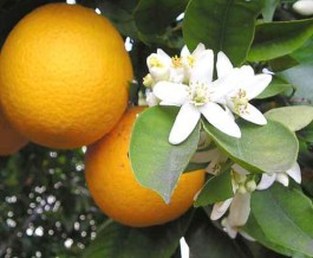
Bitter orange
Nerolidol
Boiling point:
251.6° F
Description:
Nerolidol, which is also known as Peruviol, is a naturally occurring sesquiterpenoid, of which there are two isomers- cis and trans.
Found in:
Nerolidol is found in tea leaves, ginger, lavender, honey suckle, jasmine, grape vine flowers, mango, tea tree, lemon grass, oranges, baccharis flowers, and citronella. It’s also a constituent in the essential oil of neroli, which is obtained from Seville orange flowers.
Aroma:
The aroma of Nerolidol is reminiscent of fresh tree bark. It is also described as having floral, citrus, and melon nuances.
Medicinal value:
Nerolidol acts as a sedative, and exhibits potent anti-fungal and anti-malarial properties. It’s currently being investigated as a facilitator for transdermal delivery of drugs due to its ability to penetrate the skin, and like other sesquiterpenoids ,it has the ability to pass the blood-brain barrier and enter the brain tissue. It’s unique because it’s also an inhibitor of Leishmania protozoa.
Uses:
Nerolidol is commonly used as a flavoring agent in food, and as an aroma in the perfume industry. Additionally, Nerolidol (and Farnesol) are used as pheromones by female mites to attract male mites for mating.
Physiological effects:
|
Anti-bacterial – Destroys or inhibits further bacterial growth.
Anti-fungal – Destroys or inhibits the growth of fungus. Anti-inflammatory – Reduces inflammation systemically. Anti-insomnia – Aids in falling asleep or staying asleep. Anti-leishmania – Acts against or inhibits leishmaniasis. Anti-malarial – Prevents or cures malaria. |
Anti-microbial – Destroys or inhibits further growth of microorganisms.
Antioxidant – Prevents the damage of oxidation to other molecules in the body.
Antiparasitic- Destroys or inhibits the growth and reproduction of parasites. Antiseptic – Prevents or inhibits microorganisms. Antiulcerogenic- Prevents or heals ulcers. Sedative – Calms, soothes, and promotes sleep |


Suriname cherr
Boiling point:
212° F
Description:
Ocimene is a group of isomeric monoterpene hydrocarbons consisting of αlpha-Ocimene, and two βeta-ocimenes which exist as, cis and trans forms, which are commonly found in combinations of the various forms. Ocimene is isomeric with Myrcene.
Found in:
Ocimene is found in thyme, basil, alfalfa, cone marigold, chamomile, suriname cherry, honeysuckle, tarragon, calamus, fever plant, and snapdragon.
Aroma:
The mixture of Ocimenes have a medium strength, floral, ginger, herbacious aroma with a wet cloth note. They also exhibit the green odor of unripe mangos and other tropical fruits.
Medicinal value:
Ocimene has been shown to have anti-bacterial, anti-fungal, antioxidant, antiseptic, and anti-viral properties.
Uses:
Because of its pleasant odor Ocimene is used as a fragrance additive in perfumes, as well as a flavoring agent in food. In nature this terpene acts as part of certain plants defense tactics, and is a component of the chemical communication system of certain insects such as the tea weevil, boxelders, honey bees, cotton bollworm, and predatory mites.
Physiological effects:
|
Anti-bacterial – Destroys or inhibits further bacterial growth.
Anti-fungal – Destroys or inhibits the growth of fungus. Antioxidant – Prevents the damage of oxidation to other molecules in the body. |
Antiseptic – Prevents or inhibits microorganisms.
Anti-viral – Destroying or inhibiting the growth and reproduction of viruses. Decongestant – Relieves nasal congestion. |

Phellandrene
Boiling point:
339.8° – 341.6° F
Description:
Phellandrene is the name for a pair of organic compounds- αlpha-Phellandrene and βeta-phellandrene, which are cyclic monoterpenes. Phellandrene belongs to the least stable of the terpenes, and was named after Eucalyptus phellandra (which is now called Eucalyptus radiata).
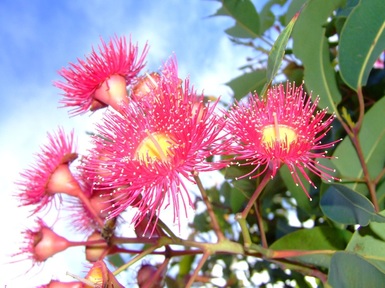
Eucalyptus
Found in:
Phellandrene was first discovered in the essential oil of water fennel. Both the αlpha and βeta isomers have been found in a multitude of plants including silver fir, Siberian fir, Canadian fir, Balsam fir, Douglas fir, ginger, pepper, juniper, magnolia, sasafras leaves, geranium leaves, mango, eucalyptus, frankincense, lovage, curry leaf, and dog fennel. Additionally, Phellandrene is commonly found in the essential oils of eucalyptus oil, tea tree oil, bitter fennel oil, water fennel oil, Canada balsam oil, gingergrass oil, schinus oil, Spanish turmeric oil, black pepper oil, Ceylin and Seychelle cinnamon oil, elemi oil, angelica root oil, star anise oil, pine needle oil, dill seed oil, bay oil, ginger oil, pepper oil, wormwood oil, golden rod oil, lemon oil, olibanum oil, cumin oil, andropogon oil, angelica oil, pimenta oil, bayberry oil, lovage leaf oil, peppermint oil, camphor oil, coriander oil, curcuma oil, and oils from sassafras bark and leaves. Phellandrene has been detected in small percentages in a few ‘mostly sativa’ cannabis strains, while it’s not found in ‘mostly indica’ strains.
Aroma:
It has a medium strength smell that is reminiscent of peppermint with herbal, green fruit, black pepper nuances.
Medicinal value:
Phellandrenes therapeutic effects can rival that of Eucalyptols. Recent research has shown that Phellandrene has anti-depressive effects. Many oils that contain Phellandrene are preferred for the treatment of lung disease.
Uses:
The Phellandrenes are often used in fragrances because of their pleasant aromas, as well as in food products as a flavor additive due to its terpenic citrus, lime notes. Additionally, insects use Phellandrene as a pheromone.
Physiological effects:
|
Anthelmintic – Expels or destroys parasitic worms.
Anti-bacterial – Destroys or inhibits further bacterial growth. Anti-depressant – Relieves symptoms of depression. |
Antioxidant – Prevents the damage of oxidation to other molecules in the body.
Immunostimulant – Stimulates the immune system. |

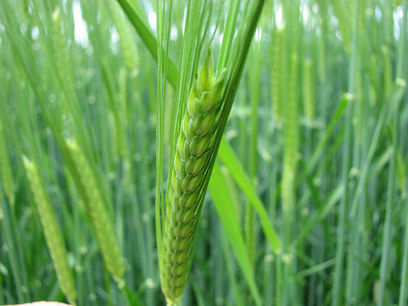
Barley
Phytol
Boiling point:
399.2° F
Description:
Phytol is an acyclic monounsaturated diterpene alcohol. It is a large, oily, molecule and is derived from the breakdown of chlorophyll. It’s used as a precursor in the formation of both vitamin E and vitamin K.
Found in:
Phytol has been isolated in nettles, barley, and aged green tea.
Aroma:
Unlike many other terpenes, phytol has a very mild odor. Faint floral, green tea, and balsamic nuances can be detected.
Medicinal value:
Phytol can suppress the immune system and impede the activity of aflatoxins (a mycotoxin) in the body, which are toxins that are produced by mold and fungus. It’s also been shown to prevent Vitamin A teratogenesis, and inhibits the enzyme that degrades the neurotransmitter GABA, which may partially account for its relaxing effects. Phytol is sometimes used in conjunction with Linalool to help in the treatment of insomnia. When used topically it can help to reduce itching and to treat slow-healing tissue wounds. Plus Phytol can help lower cholesterol and promote insulin production, possibly restoring the metabolic functions of a type 2 diabetic.
Uses:
Phytol is used in various household products like soaps and detergents. It’s a non-toxic yellow pigment, so is suitable for dying food products. Insects, like the sumac flea beetle, use Phytol and its metabolites as chemical deterrents against predators. The insects acquire these compounds from host plants.
Physiological effects:
|
Anti-cholesterolgenic- Reduces the occurrence of heart disease.
Anti-diabetic – Prevents or alleviates diabetes. Anti-pruritic – Prevents or relieves itching. |
Anti-insomnia – Aids in falling asleep or staying asleep.
Immunosuppressive – Reduces the activation efficacy of the immune system. |

Pinene
Boiling Point:
312.8° F
Description:
Pinene, also known as Terpenthene, Nopinene, and Pseudopinene, is produced from Geranyl Pyrophosphate. It’s one of the most important bicyclic monoterpenes. It’s made up of two structural isomers which are αlpha-pinene and βeta-pinene, which are derived from wood turpentine. It commonly reacts with other chemicals and can form other terpenes like D-Limonene, α-Terpineol, Borneol, and Camphene.
Found in:
Pinene is the most widely encountered terpene in nature, and is important physiologically to plants, animals, and the environment. Both the αlpha and βeta forms are important constituents of pine resin, with αlpha-Pinene being the dominant form found in cannabis. It’s a consituent in pine, cypress, and other cone bearing conifers, and also in rosemary, mango, tarragon, basil, parsley, dill, olives, rosemary, stinkwort, pine nuts, yarrow, rose, cumin, hops, bergamot, lemon and orange peels, big sagebrush, eucalyptus, spearmint, elderberry, nutmeg, peppermint, lavender, cheken leaves, juniper, fever plant, calamus, ironwort, European silver fir, Siberian fir, Canadian fir, Balsam fir, Douglas fir, Sassafras bark and leaves. The ethereal oils that are prepared from different varieties of plants are especially rich in Pinene. They include bay oil, camphor oil, coriander oil, fennel oil, oil of massoy bark, oil of myrtle, Ylang-Ylang oil, parsley oil, oil of rosemary, oil of turpentine, pine tar oils, larch needle oils, sweet basil oil, kesso-root oil, sandarac oil, cypress oil, oils of galagnal, oil of spike, oil of star anise, oil of thyme, oil of water fennel, dill seed oil, hyssop oil, makrut lime peel oil, oil of valerian, masaoi bark oil, nutmeg oil, asarum oil, merican peppermint oil, Canadian Snake root oil, carrot oil, galbanum oil, niaouli oil, canella oil, cinnamon root oil, French basilicum oil, tansy oil, cajeput oil, thyme oil, ajowan oil, and hemlock needle oil.
Aroma:
It has a deep, woody-green,, pine-like, lime, menthol aroma which can have a slight nail polish-remover nuance..
Medicinal value:
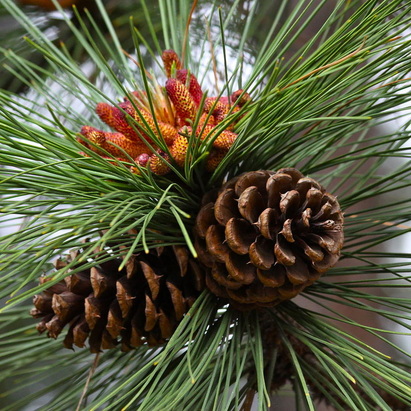
Pine
Pinene has been used for centuries as a bronchodilator to increase airflow to the lungs, and is therefore effective in the treatment of asthma. It produces a bronchodilator effect that gives the sensation of sucking more air which can lead to coughing or hyperventilation. When smoking or vaporizing cannabis, coughing can produce a larger absorption of cannabinoids by increasing plasma concentrations, and subsequently, increasing the cannabinoids effects. Pinene is crucial to the human body because it forms the biosynthetic base for CB2 ligands in the endocannabinoid system, and it also has the ability to block the inflammatory signal of prostagladins, in a similar way to Myrcene. Pinene is able to cross the blood-brain barrier very easily, and has been shown to fight cancer by encouraging apoptosis (the death of cells that occurs as a normal and controlled part of an organism’s growth) in the cancer cells. Pinene acts as an inhibitor of acetylcolynesterasics, which prevents the destruction of molecules responsible for the transmission of information, and as a result, it spurs alertness and improves memory retention. Rosemary and sage are both considered “memory plants” due to the presence of Pinene. Concoctions made from their leaves have been used for thousands of years in traditional medicine to retain and restore memory. Assuming the same is true for the Pinene present in cannabis, it could prove to be beneficial in the clinical treatment of Alzheimer’s disease. An individuals memory will fail more after using THC alone, than when THC is accompanied by Pinene. Like many terpenes and cannabinoids, Pinene is both an analgesic and anti-inflammatory which makes it useful for a sufferer of chronic pain. Additionally, Pinene has significant antibiotic effects against antibiotic resistant pathogens, and it acts as an expectorant, a topical antiseptic, and improves personal satisfaction and energy.
Uses:
Pinene has major uses in the aromatherapy industry and as a fragrance additive and a flavoring agent in food. The αlpha and βeta isomers are each used by many insects as aggregation pheromones in their chemical communication systems, and also as an insect repellent, depending on the species.
Physiological effects:
 Elderberry AChE inhibitor – Stops the action of the protein that destroys acetylcholine. Analgesic – Relieves pain. Anthelmintic – Expels or destroys parasitic worms. Anti-bacterial – Destroys or inhibits further bacterial growth. Antibiotic – Destroys or kills established microorganisms. |
Anti-fungal – Destroys or inhibits the growth of fungus.
Anti-herpetic – Inactivates herpes virus. Anti-inflammatory – Reduces inflammation systemically. Anti-microbial – Destroys or inhibits further growth of microorganisms. Antineoplastic – Prevents or inhibits the maturation and proliferation of malignant cells. Antioxidant – Prevents oxidation damage to other molecules in the body. Antiseptic – Prevents or inhibits microorganisms. Anti-viral- Destroys or inhibits the growth and reproduction of viruses. Brochodilator – Increases airflow to the lungs. Diuretic- Increases the flow of urine. Expectorant –Helps discharge phlegm from the respiratory tract. Immunostimulant- Stimulates the immune system. Insecticide – Kills insects. Insectifuge – Repels insects. Nootropic – Enhances memory or other cognitive functions. Rubafacient – Causes irritation and reddening of the skin, due to increased blood flow. |

Pulegone
Boiling point:
435.2° F
Description:
Pulegone is a naturally occurring monocyclic monoterpene.
Found in:
It’s a major constituent of the volatile oils of European and American pennyroyal, as well as in cat nip oil, calamint oil, peppermint oil, mountain mint oil, and buchu leaf oil. It’s only a minor constituent in cannabis.
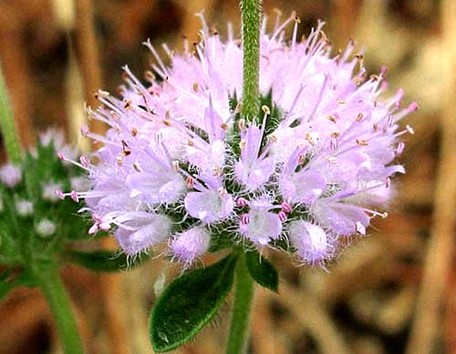
Pennyroyal
Aroma:
Pulegone has a pleasant minty-camphor odor that is similar to pennyroyal.
Medicinal value:
Pulegone, much like Pinene, Eucalyptol, and Terpinene, is an acetylcholinesterase inhibitor, meaning that it may counteract some of THC’s activity which leads to lower acetylcholine levels. It stops the action of the protein that destroys acetylcholine, which is used by the brain to store memories. The result is that you forget more on THC alone than you would on THC accompanied by Pulegone. It should be noted that Pulegone can be toxic in high doses, causing pulmonary and central nervous system toxicity.
Uses:
Pulegone is used for flavoring in the candy industry, and to create an abundance of scents in the aromatherapy industry. It also happens to be the most powerful of three insecticides that occur naturally in many mint species.
Physiological effects:
|
AChE inhibitor – Stops the action of the protein that destroys acetylcholine.
Analgesic – Relieves pain. Anti-bacterial – Destroys or inhibits further bacterial growth. Anti-pyretic – Relieves or reduces fever. |
Insecticide – Kills insects.
Sedative – Calms, soothes, and promotes sleep |

Sabinene
Boiling point:
325° to 327° F
Description:
Sabinene is a natural bicylic monoterpene, and is an isomer of Thujene.
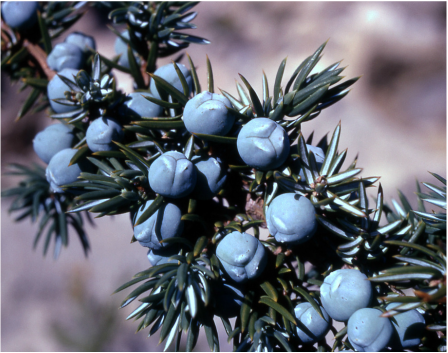
Found in:
Sabinene is a constituent in many evergreen trees including Holm oak trees, Norway spruce, and Ponderosa pine. It’s also found in juniper, nutmeg, sweet marjoram, mango, and black pepper. It has been isolated in many essential oils from a variety of plants including carrot seed oil, tea tree oil, citrus oil, oil of savin, cardamom oil, nutmeg oil, hyssop oil, marjoram oil, and pilea oil.
Aroma:
The aroma is described as being a pleasant, spicy, citrus, camphoreous scent. Sabinene is one of the chemical compounds that contributes to the spiciness of black pepper.
Medicinal value:
Sabinene has been shown to have a positive effect on liver function, digestion, arthritis, and skin conditions. It exhibits significant anti-bacterial activity against Salmonella typhi, one of the causative organisms of food poisoning. Sabinene also exhibits promising anti-fungal, and anti-inflammatory activity.
Physiological effects:
|
Acaracide- Kills members of the Acari family (mites and ticks).
Anthelmintic – Expels or destroys parasitic worms. Anti-arthritic – Relieves the symptoms of arthritis. Anti-bacterial – Destroys or inhibits further bacterial growth. |
Anti-inflammatory – Reduces inflammation systemically.
Anti-fungal – Destroys or inhibits the growth of fungus. Anti-microbial – Destroys or inhibits further growth of microorganisms. |


Lilac
Terpineol
Boiling point:
422.6° -424.4° F
Description:
Terpineol is a naturally occurring, volatile monoterpene alcohol which is typically a mixture of four isomers- αlpha-Terpineol, βeta-Terpineol, gamma-Terpineol, and Terpinen-4-ol, with the primary constituent being αlpha-Terpineol. Terpineol is commonly manufactured from the more readily available αlpha-Pinene, so it is often found in strains with high levels of Pinene.
Found in:
Terpen-4-ol, along with its related isomers, are the compounds with the highest concentration in tea tree oil and nutmeg oil. It’s also found in apricot kernel, cinnamon bark, mandarin oranges, lemon peel, horsemint, eucalyptus, sage, hyssop, rosemary, parsley, cumin, coriander, basil, myrtle, laurel, thyme, sweet marjoram, celery seeds, green tea leaves, pennyroyal, stinkwort, star anise, daffodils, lilac, nutmeg, bay leaves, pepper, juniper berry, ceylon, cardamom, and marjoram. Terpineol has been isolated in many essential oils including orange oil, neroli oil, lime oil, cajuput oil, pine oil, camphor oil, erigron oil, petitgrain oil, kesso oil, kuromoji oil, lovage leaf oil, marjoram oil, lignaloe oils, lovage root oil, hyssop oil, cajeput oil, thyme oil, cypress oil, sage oil, coriander oil, geranium oil, juniper oil, ravensara oil, and orange oil.
Aroma:
Its aroma is similar to lilacs, apple blossoms, and lime blossoms, with slight citrus, and hyacinth notes. Additionally, Terpineol gives lapsang souchong tea its pleasant aroma and distinctive taste.
Medicinal value:
αlpha-Terpineol exhibits anti-proliferative effects on human erythroleukaemic cells, and it enhances the permeability of skin to lipid-soluble compounds. Studies show that α-Terpineol inhibits the growth of tumor cells through a mechanism that involves inhibition of the NF-κB pathway. It has been suggested that blocking NF-κB can cause tumor cells to die, stop proliferating, or become more sensitive to the action of anti-tumor agents. It’s a potent inhibitor of superoxide production, selectively regulating cell function during inflammation. Additionally, it has also been described as having anti-inflammatory and analgesic properties making it effective for curing toothaches, headaches, and joint pain. The Terpinen-4-ol isomer inparticular is the most active pharmaceutical ingredient in formulations that are designed to treat a number of ocular and cutaneous diseases caused by demodicosis.
Uses:
Terpineol is used as an ingredient in perfumes, commercial soaps, and disinfectants. It’s commonly used as a flavoring agent and is a component of dietary spices and herbs. Terpineol is also used in folk medicine and is a constituent of some inhalants and syrups that are marketed over-the-counter. In addition, Terpineol also acts as a solvent, and a foaming agent in the flotation of ores in nonferrous metals.
Physiological effects:
|
Acaracide- Kills members of the Acari family (mites and ticks). AChE inhibitor – Stops the action of the protein that destroys acetylcholine. Analgesic – Relieves pain. Anti-bacterial – Destroys or inhibits further bacterial growth. Antibiotic – Destroys or kills established microorganism. Anti-inflammatory – Reduces inflammation systemically. Antineoplastic – Prevents or inhibits the growth or development of malignant tumor cells. Diuretic- Increases the flow of urine. Immunostimulant – Stimulates the immune system. Insecticide – Kills insects. |
Nootropic – Enhances memory or other cognitive functions.
Sedative – Calms, soothes, and promotes sleep
|

